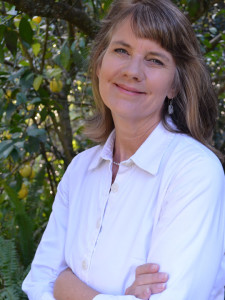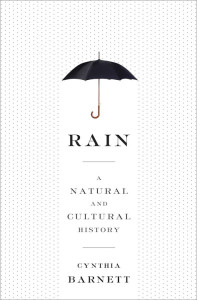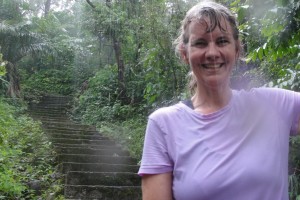It rained and then rained some more on the Sunday afternoon I finished reading Rain: A Natural and Cultural History. Florida author Cynthia Barnett’s descriptions of the drenching joy of India’s monsoon rains made me want to feel the raindrops on my skin. I walked outside without an umbrella. The drops were cold. Around me, the sky was a thick gauze, a white cloud that hung over everything from the top of the sky to the horizon. “We live submerged at the bottom of an ocean of air,” Barnett quotes the Italian physicist whose work led to the invention of the barometer as saying. That’s exactly how it felt.
I didn’t expect to be so overwhelmed by a book about rain any more than I expected to be besotted with orchids when I read The Orchid Thief by New Yorker writer Susan Orlean. Both are books of astonishing scientific, poetical and first-hand adventure.

But Barnett’s book is about something basic and elemental.
In Rain, Barnett marshalls dazzling detail as she explains the science of rainfall, the history of weather forecasting and our efforts to control the rain through prayer and plumbing. She tells of floods and droughts, of thousands of lives lost in deadly disasters, such as the industrial London Smog of 1952 that killed 12,000, or the Great Mississippi River Flood of 1927 that killed untold thousands of the Delta’s poor blacks and left 637,000 people homeless.
But she also gives the reader the poetry of rain and the wonderment of it. While her writing is lyrical, it’s never overwrought. She puts her writing at the service of the subject. She has a big story to tell and a whole bunch of little ones on the way to the story of rain and our relationship with it.
She writes about the names various cultures give to rain, such as the Welsh describing a heavy rain as raining old women and walking sticks. She writes about the earliest rain god worshipped by humans, Iskur or Adad; of women burned at the stake for weather-making; of the invention of waterproof fabric used for the Mackintosh raincoat, and the black smoke that belched from the clothing factory. She also writes about perfumers in India who capture and bottle the scent of the first monsoon rains, which once dropped an astonishing 86 feet of rain one year. When telling the history of umbrellas and umbrella making, she talks about the colorful and patterned bamboo and oiled paper umbrellas that filled city streets in Japan before the 1950s and how the artist Stephan Kohler described them with poetic perfection as “private skies.”
In the chapter “Strange Rains,” she tells how in 2001, a scarlet red rain fell in India, which scientists expected to contain dust from the desert. But instead they found particles that resembled biological cells. A meteor had incinerated over earth the day the rain fell and when the particles were later heated to 250 degrees Fahrenheit for two hours, they began to reproduce.
Barnett’s science journalism combined with powerful lyricism gives Rain its resonance and prompted nominations for several prestigious awards, including the 2016 PEN/E.O. Wilson Literary Science Writing Award. Rain was also a finalist for a National Book Award in 2015 and a just-announced Florida Book Award. It’s been reviewed in the Los Angeles Times, the New York Times, and was included on best books lists of 2015 by NPR Science Friday, the Miami Herald, the Tampa Bay Times, Kirkus Review, the Boston Globe and others.
As I read Rain in the waiting room of my doctor’s office, in a coffee shop, sitting on a yoga mat outside my apartment and sprawled over my living room sofa, I wanted the world to be quiet so I could hear this book.
And I didn’t just want to read it; I wanted to memorize it.
* * *
Barnett became a water expert during her 15 years as a senior writer for Florida Trend magazine where she reported on the business of water. She resided in St. Petersburg where the magazine is based before resigning in 2013 to write this book. She wrote her first two books, Mirage: Florida and the Vanishing Water of the Eastern U.S. and Blue Revolution: Unmaking America’s Water Crisis while still writing for the magazine. She says she got to the point where all she wanted to write about was water. When she was organizing Rain, Barnett remembers editor Mark Howard’s counsel that you can’t go wrong with organizing a story chronologically. That’s the way we naturally tell a story, so it is an organization that works, Barnett explains. For Barnett that meant beginning Rain with the origins of the planet.
 In the prologue, she describes the Earth as a “red-faced and hellish infant” for its first half-billion years, hotter than the sun. Meteors streaming toward the planet incinerated and spewed steam that instantly evaporated. If any water hit the earth, it sizzled away. She explains how the planet eventually cooled enough, and for long enough, that water collected heavily in the atmosphere where it became so swaddled in water that it rained and rained for thousands of years — until water filled every crevice, seeped below the earth to fill the aquifers, cut channels where the first rivers flowed and gathered in the seas that enclose the continents. But that made our life possible. Chapter One is aptly titled, “Cloudy with a Chance of Civilization.”
In the prologue, she describes the Earth as a “red-faced and hellish infant” for its first half-billion years, hotter than the sun. Meteors streaming toward the planet incinerated and spewed steam that instantly evaporated. If any water hit the earth, it sizzled away. She explains how the planet eventually cooled enough, and for long enough, that water collected heavily in the atmosphere where it became so swaddled in water that it rained and rained for thousands of years — until water filled every crevice, seeped below the earth to fill the aquifers, cut channels where the first rivers flowed and gathered in the seas that enclose the continents. But that made our life possible. Chapter One is aptly titled, “Cloudy with a Chance of Civilization.”
The book is a dizzying compendium of information. Indeed, there are so many fascinating stories in the book that the reader isn’t entirely sure at times exactly where Barnett is going. But Barnett’s mastery of her material made me happy to follow.
Although the through-line of the book isn’t obvious, Barnett explains that the organizing theme is human hubris, particularly of modern Western humans, to believe we can control and dominate nature and bend it to our needs, rather than trying to understand it and live in harmony with it. We erect subdivisions in places too wet to build and grow corn in places to dry to farm, she told an interviewer from the Society of Environmental Journalists.
“Humans have this innate hubris; we want to control nature and we were convinced from the time of the earliest rain god, Iskar, that we could pray to him to bring rain or that we could pray to stop rain,” she told Florida Field Notes.
As an example of our attempt to control rain, the U.S. Congress allocated $9,000 in 1890 for experiments to blast the sky with cannons and other explosives to see if rainmaking by concussion might bring rainfall to arid farmland.
With changes in the global climate, she says, we are today altering the weather and may be permanently altering the climate of the planet.
“The great irony is that we did manage to alter the weather patterns, only not in ways that we would have ever expected,” she says.
Barnett also reports how some cities are re-thinking old ideas that treated rain as a problem to be disposed of. In Tuscon, Arizona, the city tore out asphalt spillways and planted native vegetation so that floodwaters from what she describes as North American monsoons can fill natural basins, berms and desert gardens. While most cities face water limits, Tuscon is returning more water to the aquifer than its people use.
But change like that usually doesn’t happen without a crisis, she notes. In response to the California drought, Los Angeles is retrofitting its storm system to capture the rain it once tried to shunt as efficiently as possible to the sea. If people had a better understanding of the natural hydrologic cycle and developed ways to conform to it and live with it, Barnett says we would live more in harmony with the earth and our weather cycles.
“The theme of the book is our great misunderstanding of our weather and our climate,” she said. “People don’t understand their backyard hose is directly connected to the Floridan Aquifer and the beautiful springs in our state. They don’t understand the fertilizer they put on their yards today will harm the St. Johns River tomorrow and that all our food and energy sources have profound impacts on our water and on the entire hydrological cycle.
“I think that is a fundamental reason why we can’t seem to solve our environmental crises, why we have the fish kill in the Indian River or the algae bloom outbreaks in the St. Johns River, is that we have just this incredible misunderstanding and disconnectedness between the self and the natural world,” she said. “And that is really hurting us now.”
Barnett has been gratified at the public response to the book. She said many people use the word “inspired” to describe their reaction. They want to tell her about childhood memories of a rainstorm, or tell her about the scent of rain they experienced in a particular beloved place. It’s made her rethink how environmental writing should approach its audience. Touching upon the wonder of the natural world and on fundamental and common connectedness in the human experience grounds the science, she says. Barnett describes her audience as “the caring middle.”

“I didn’t realize the extent to which other people feel about rain as I do. It is a wonderful shared human experience.” Barnett told Florida Field Notes. “It can be a frightening experience or a miserable shared experience. The beauty of it is that it is a shared experience.”
Barnett is a fifth generation Floridian who lived in LaBelle, Miami and Pensacola before her family moved to Los Angeles in 1977 when she was 11 years old. But she always missed Florida. She remembered the blazing hot summers in Florida as a child with the whine of cicadas growing louder and louder as the day grew hotter and hotter. (I know that sound. It feels like the sound of boredom itself.) Then she recalls how the heat would give way to epic thunderstorms and torrential rains and how she loved the way the earth was washed by the rains and cooled. Barnett returned to Florida and earned an undergraduate degree in journalism at the University of Florida, followed by a master’s in environmental history. She now lives in Gainesville with her husband and two children where she teaches a course on environmental journalism. She says she needs Florida as a writer. She describes it as a muse.
“I still feel oppressed by the sun on a hot sunny day, and I think storms give life a wonderful beauty and drama,” she told Florida Field Notes. “They can be frightening sometimes, but for the most part they are a blessing. They bring rain and they bring water and they bring a lot of excitement to an otherwise dull Florida day.”
Selling a book about rain wasn’t an easy pitch. Barnett remembers two rejection letters she received on the same day, each painful in its own way. One publisher wrote, “This is a great idea, but you do not have the chops to pull this off.” And the other proclaimed, “You are a beautiful writer, but this is not a good idea.” Both were wrong.
“The field of book publishing is so capricious and so unfair. It is such a painful feeling that you absolutely have to believe in yourself, go into it believing in yourself and your ability to tell a story,” she said.
* * *
As I tiptoed through the torrent of the storm water rushing across the black top of my apartment complex toward a storm drain, I thought about how I’d begun to think of rain as a problem. When my street in flooded last year because the storm drain was clogged and water seeped into cars parked along the street, I thought of it as a plumbing problem. If the tide is high or the storm drain is clogged, the water doesn’t have anywhere to go. And I’d begun thinking of rain not as manna from heaven but as stormwater runoff, a potent toxic mix laden with fertilizers, pesticides, car oils, pet poop and other things that foul the river.
But the problem isn’t that it rains, it’s that everything we put on the ground, in the air, in the water, ends up pulled up into the atmosphere where it falls back down onto the Earth.
Barnett’s book put the emphasis where it belongs. Rain is a wonder. How we live with it is our challenge.
Rain: A Natural and Cultural History by Cynthia Barnett. Hardcover published by Crown Publishers at Penguin Random House: $25. Paperback released April 5 by Penguin Random House: $17. Ebook available for $12.99
Susan Cooper Eastman is an award-winning Florida journalist and contributor to Florida Field Notes.


4 Responses
Happy Mothers Day Quotes 2016
Aw, this was a really nice post. Taking a few minutes and
actual effort to produce a very good article… but what can I say… I procrastinate
a lot and don’t manage to get nearly anything done.
editor@floridafieldnotes.com
Thanks – glad you liked it! You’re right – it’s a lot of work to produce quality content, but it’s nice when it gets recognized. Thanks again!
wwe payback 2016 results
After looking over a handful of the blog articles on your web site,
I truly appreciate your technique of blogging. I saved
as a favorite it to my bookmark website list and will be checking back soon. Please visit my
web site too and let me know how you feel.
editor@floridafieldnotes.com
Thank you so much for the nice feedback! Journalism is a lot of work, but rewarding. We’re happy you’ve enjoyed some posts. Thanks for stopping by!